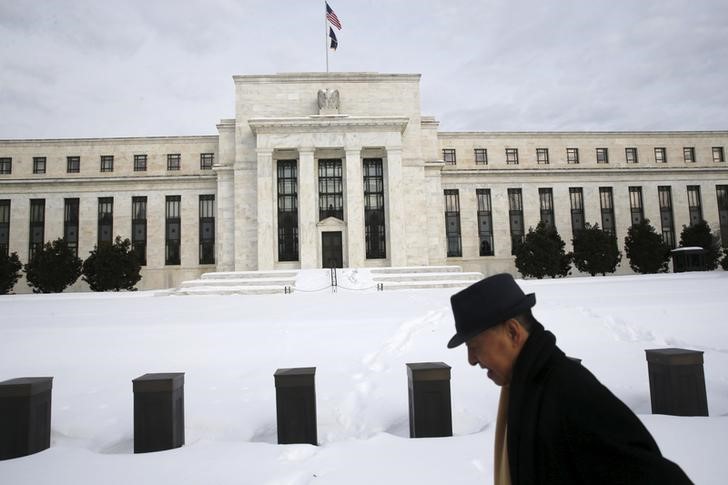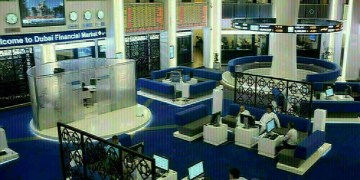 © Reuters. Five Questions Fed Policy Makers Must Answer in 2018: Tim Duy
© Reuters. Five Questions Fed Policy Makers Must Answer in 2018: Tim Duy(Bloomberg View) — The Federal Reserve anticipates continued monetary tightening in 2018, as it seeks to match 2017’s pace of hikes with another three quarter-point moves. As always, however, that projection depends on actual economic outcomes. With that in mind, here are five questions the Fed will face in 2018 as it charts a course for policy:
Is this the year inflation begins to pick up?
is always just a year away in the Fed’s forecast, and this year is no exception to that rule. In general, central bankers maintain that temporary factors such as declining mobile-phone service costs accounted for this year’s inflation shortfall. Hence, policy makers expect core inflation to accelerate to 1.9 percent in 2018 as those factors dissipate. Another inflation disappointment in 2018, however, would increase chatter at the central bank that maybe inflation expectations are declining and need to be bolstered with a more gradual path of tightening. Still, remember that the Fed retained its plan for three rate hikes in 2017 despite weak inflation. The same is likely to happen again if labor markets hold strong.
Will job growth slow as expected?
— currently a monthly average of 170,000 over the past three months — remains sufficient to put downward pressure on . Yet the Fed anticipates just a 0.2 percentage-point decline in the unemployment rate, compared with a 0.6 percentage-point decline last year. The Fed probably remains too pessimistic on labor market improvement in the coming year. If their pessimism is wrong and wage growth accelerates, policy makers will lean toward the hawkish side of their projections. But a continuation of the low-wage-growth, low-inflation environment would shift the focus toward revising downward estimates of the longer-run unemployment rate consistent with stable inflation.
Are policy makers underestimating the impact of the tax cuts?
Fed officials began adding the impact of tax cuts into their forecasts shortly after Republicans took control of Congress and the White House. When combined with the stronger-than-expected activity of the last three quarters, the Fed’s 2018 GDP forecasts rose from 2.1 percent to 2.5 percent over the past year. But here again the Fed may be too pessimistic. With the U.S. economy looking to finish the year on a strong note with a third consecutive quarter of greater than 3 percent , it doesn’t take much imagination to see the tax cut producing a temporary but greater-than-expected boost to 2018 numbers. If so, the Fed would be faced with a much stronger economy than it anticipates.
Should the Fed care about inverting the yield curve?
Despite the inverted yield curve’s record of predicting recessions, traditionally the Fed has been wary of reading too much into the yield curve. But some policy makers, such as reserve bank presidents and , warn that the Fed should be wary of inverting the yield curve. With many analysts expecting the Fed to invert the yield curve in 2018, this issue will become more of a sticking point for some policy makers. Nonetheless, I expect yield-curve concerns will remain a minority position in the Fed as long as growth stays on a solid track. If so, the Fed will find a reason to disregard the yield curve and keep hiking after any inversion occurs.
Will financial stability concerns affect rate policy?
Although equity prices are elevated valuations relative to traditional metrics, central bankers have been wary of using rate policy to respond to higher asset prices and instead rely on regulatory oversight to keep an eye on potential build-up of excessive leverage in the financial system. But some problems fall through the cracks with that approach, as we saw with mortgage assets during the financial crisis. Is the current cryptocurrency mania also falling through the cracks? Is this a sign that financial conditions are too accommodative despite the rate hikes to date? This may be the year that monetary policy makers decide they can no longer sit on the sidelines with regards to this issue.
Finally, as we think about these issues, note that the Fed will be navigating these waters with a new captain as Chair is succeeded by Governor . Plus, there will be a new crew in the form of Randy Quarles and, if confirmed, Marvin Goodfriend. Moreover, the more dovish voting members of the Federal Open Market Committee such as December dissenters Kashkari and rotate off in favor of the more hawkish voices such as and . On net, the Fed will find more reasons to hike rates than hold steady in 2018, leaving the current three hike projection as the best bet.
This column does not necessarily reflect the opinion of the editorial board or Bloomberg LP and its owners.
Tim Duy is a professor of practice and senior director of the Oregon Economic Forum at the University of Oregon and the author of Tim Duy’s Fed Watch.
Source: Investing.com




























